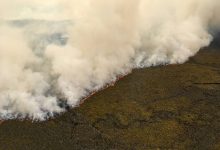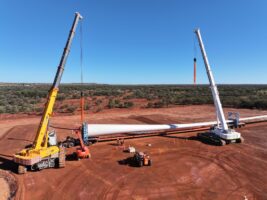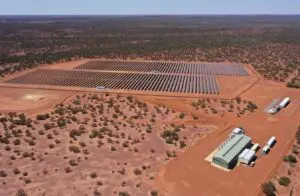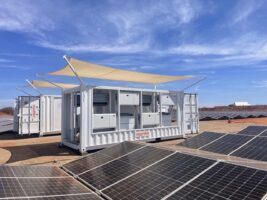Residential and commercial solar could assist in detecting wildfires, if the systems were able to share the real-time data they collect that indicates smoke cover.
PV (photovoltaic) systems could provide an early warning detection of wildfires by measuring fine particulate matter, or PM2.5, in the air and comparing solar panel performance to a normal clear day. Add in observations of solar irradiance, weather data, and thousands of residential PV systems, and a widespread smoke monitoring network could be achievable.
Researchers from the University of New South Wales (UNSW) studied data from 160 residential PV systems in NSW collected during the 2019-2020 Black Summer bushfire season.
They found that not only are solar panels more effective than particulate matter sensors because they don’t need to be cleaned and recalibrated to provide reliable readings, but the reduction in generation was enough to consider turning these devices into an early warning system.
“We postulate that PV power can be used as a rough predictor for PM2.5 concentration,” they said in a paper published in eScience this month.
Using rooftop PV to create a useful bushfire warning system would require a few other moving parts, but would be most useful in regional areas where there are still many residential solar systems but few weather stations, says lead author Bram Hoex.
“You would have to combine it with a bit of yield prediction, which is not that difficult with satellite information on cloud cover and other systems that we have available which are not affected by smoke. If you see an unexpected decrease in performance of your PV system which is not coming from cloud cover you can then use that as a sensor,” he told RenewEconomy.
And Australia is not short of solar panels.
By the end of 2023, PV capacity in Australia reached 34.2 gigawatts (GW), according to the Australian Photovoltaic Institute. At the start of February, those panels accounted for 40 per cent of East Coast energy generation, shows Australian Energy Market Operator (AEMO) data.
Ethan Ford, the corresponding author on the study, says they had to filter out hundreds of PV systems that weren’t close enough to PM2.5 monitoring sites, which are mainly strategically positioned around populated areas.
But if they were able to establish a specific sensitivity constant (performance reduction rate) to predict smoke concentrations with greater precision than just looking for smoke in the sky, that could make PV panels in more rural areas or even towns useful for smoke detection.
“The presence of smoke may be detected by PV systems at concentrations lower than we can see. This would allow us to understand the smoke distribution, help understand the fire distribution, and plan ahead given wind conditions,” Ford told RenewEconomy.
“Thus, PV systems could create a scalable widespread network of monitoring locations that isn’t locally biased.”
Smoke cost solar owners $29m during Black Summer
The research, inspired by similar studies from India, Singapore and China, used home monitoring data from Solar Analytics and found that over the course of a moderately hazy day, one system in Wagga Wagga saw power output reduced by about 17 per cent due to the Black Summer bushfires.
The total energy loss over the 71-day period for all 160 systems is estimated at about 4.2 per cent.
Mapping that out over the entire state means NSW lost an estimated 175 gigawatt hours (GWh) of energy production due to smoke, or about $US19 million ($A29 million) worth of revenue for residential and utility solar owners.

(A) Normalized PV generation by hour (from 80-percentile filter) and PM2.5 range (μg/m3) plotted against the mean PM2.5 concentration for those measurements.
(B) Normalized PV generation plotted against the air mass-corrected PM2.5 concentration—equivalent to the product of air mass and PM2.5.
But while these numbers sound worrying, the researchers also found the losses from smoke weren’t an overall grid risk.
“Residential PV systems are typically designed to maximise daily energy production during winter. Thus, they overproduce in summer when wildfires are most frequent, often resulting in clipping as the inverter capacity is lower than the sum of the DC capacity of the solar panels,” the paper said.
The data showed that more than 16 per cent of the solar systems automatically clipped their output during the fire period. Losses caused by smoke can be partially compensated by reduced curtailment.
Masses of data lead to new findings
Dust and air pollution look the same in this data, but Ford says their analysis can correct for the larger particles in dust.
- “Dust is typically comprised of PM10 (more coarse particles); both of which reduce PV system performance. Our analysis corrects for dust, or soiling, on the PV modules by comparing the performance of each PV system against itself under different concentrations of PM2.5. We even saw the impact of dust from coal mines on PM2.5 sensors in the data of our study,” Ford says.
“In practice, the PV systems would likely not differentiate between concentrations of PM2.5 and PM10 when monitoring for wildfire smoke, but instead give a PM2.5-equivalent concentration. (Similar to how methane and other greenhouse gases are described by their CO2-equivalent). I think it’s important to report high concentrations of particulate matter, regardless of its type, as they pose a serious health threat to our communities.”
The researchers were able to compare individual panels’ performance on clear sky days in November with performance on smoke days during the same period, because they had so much data.
The researchers may have only used data from 160 systems, but Ford says they had access to data from 710. That meant they were able to use each solar panel as a reference against itself, without having to indulge in complicated modelling.
The other innovation in the study was adjusting for the distance that light travels: light must travel further through the air mass in the morning and evening.
“Because we had so much data we were able to extract that. That’s still something that we’re investigating. We saw more losses in the morning than in the afternoon, even if you correct for air mass, so that’s something we’re trying to unravel,” Hoex says.










